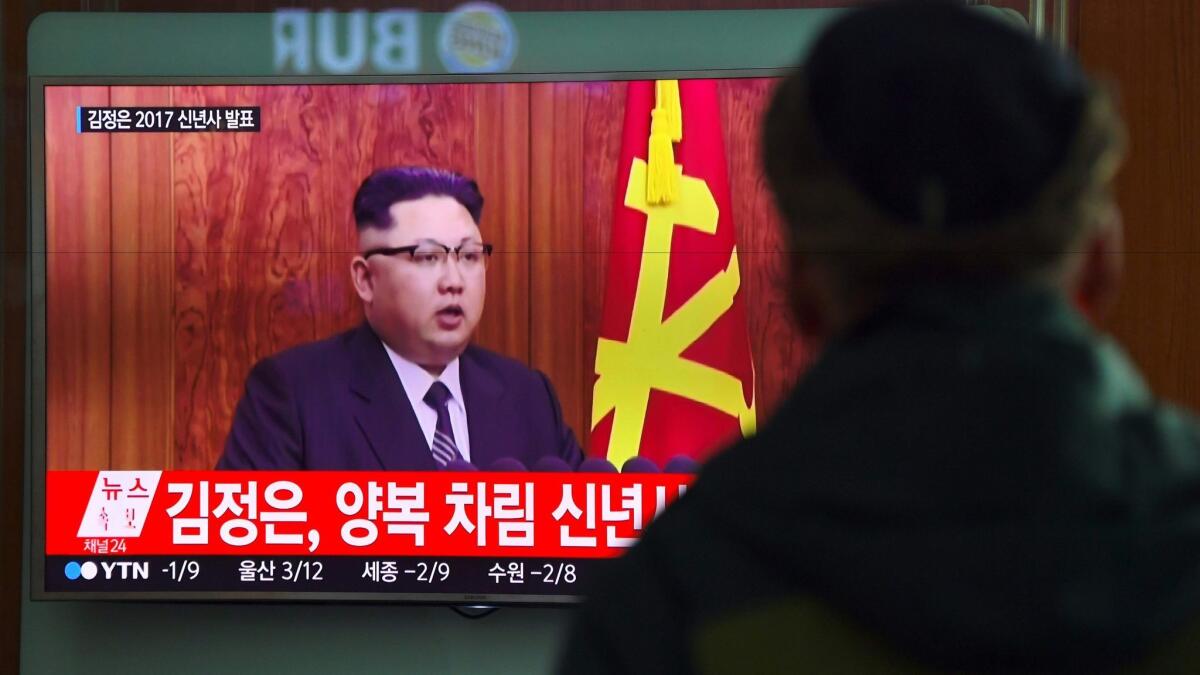South Korea says North Korea fired a missile into the Sea of Japan

Reporting from Seoul, South Korea — North Korea on Sunday morning deployed what may have been a ballistic missile into the Sea of Japan, South Korea officials said.
The projectile was North Korea’s first missile test-firing since Donald Trump became U.S. president last month, and its first provocation since leader Kim Jong Un boasted of his country’s goal to deploy an intercontinental ballistic missile.
The type of missile, launched just before 8 a.m. local time from a western province in North Korea, had not yet been identified. Neither had its flight path, according to South Korea’s Yonhap news agency.
North Korea is prohibited from carrying out ballistic missile launches under United Nations Security Council resolutions aimed in part at curbing the country’s development of nuclear weapons.
At a brief news conference late Saturday night with President Trump in Florida, Japanese Prime Minister Shinzō Abe called the missile launch “absolutely intolerable.”
“North Korea must fully comply with the relevant U.N. Security Council resolutions,” he said.
Trump, in a one-sentence statement, did not address the launch directly but said the U.S. stands behind Japan, “it’s great ally, 100%.” He and Abe vowed to strengthen the U.S.-Japan alliance and left the stage without taking questions.
South Korea’s acting leader, Prime Minister Hwang Kyo-ahn, responded to the test Sunday morning during a meeting about a recent avian influenza outbreak.
“North Korea fired a projectile that appears to be a ballistic missile,” he said. “Together with the international community, the entire South Korean government is trying its best to respond with the relevant punishments.”
Military sources told Yonhap that they were trying to determine whether the missile was an intermediate-range model, like the Musudan — or a shorter-range Rodong. They estimate it flew about 500 kilometers, much shorter than the Musudan’s estimated 3,000-kilometer range. Japan’s Kyodo News reported that the missile landed in the Sea of Japan, causing no damage.
The test-firing comes weeks after Kim said his country was close to being able to deploy an intercontinental ballistic missile — a type that in theory could reach the U.S. mainland.
A day later Trump took to Twitter, announcing confidently, “It won’t happen!”
Trump’s confidence was met with skepticism from North Korea’s security analysts, who noted that the missile issue has long confounded the international community — and that Trump hasn’t detailed a strategy for dealing with the North.
Despite the U.N. restrictions, Kim’s government has escalated its missile and nuclear programs. He has ordered at least 50 missile tests since he took office five years ago, including more than 20 last year. He has also presided over three nuclear tests — two of which were in 2016.
Harry J. Kazianis, director of defense studies at the Center for the National Interest, a Washington, D.C.-based think tank, said North Korea’s advancing technological capacity over the last decade could someday lead to the “ultimate nightmare” — a nuclear-armed long-range missile.
NEWSLETTER: Get the day’s top headlines from Times Editor Davan Maharaj »
“On the hardware front, this is a march towards an intercontinental ballistic missile that can hit the U.S. mainland, or maybe Europe,” Kazianis said. “There are some experts who believe they can do that now; I think they’re a few years off. But every time they test a missile, they get a little bit closer.
“We’re gonna have to see how this plays out,” he said. “But we have to keep in mind, every time North Korea does one of these tests, there’s a danger of one of these missiles taking a wrong turn — if one hits South Korea, you bet the South Koreans are going to respond. Or the Japanese — they’re gonna respond the same way. We’re very lucky that every time these tests happen, nobody gets hurt.”
Many analysts believe North Korea has enough nuclear material to have created as many as 12 bombs, with some estimates as high as 60. The focus for many security experts has shifted to studying how the rogue state might deliver its weapons.
One response has been the Terminal High Altitude Area Defense system, an array designed to shoot down missiles. U.S. Secretary of Defense James Mattis and South Korean leaders agreed during a recent summit to deploy the system in Seoul this year.
Many experts say urgent action is needed to slow the North’s advancement.
“I say it as clearly and as loudly as I can, we cannot do nothing,” former Defense Secretary William J. Perry said recently at a forum in Washington, D.C. “The time for patience is over. Because time is really not on our side. I emphasize that as clearly as possible: Time is not on our side. We have to do something.”
Stiles is a special correspondent. Times staff writer Jonathan Kaiman in Beijing contributed to this report.
MORE WORLD NEWS
Senior North Korean defector says his sons were reason he fled
An interrupted journey ends in a new life in the U.S. for Syrian refugee family
Mexican military helicopter fires on drug kingpin hideout in one of two raids that left 12 dead
UPDATES:
8 p.m.: This article was updated with remarks by President Trump and Japanese Prime Minister Shinzō Abe.
7:25 p.m.: This article was updated throughout with Times reporting.
This article was originally published at 5:55 p.m.
More to Read
Sign up for Essential California
The most important California stories and recommendations in your inbox every morning.
You may occasionally receive promotional content from the Los Angeles Times.











